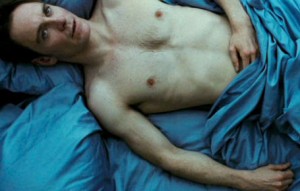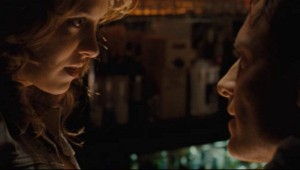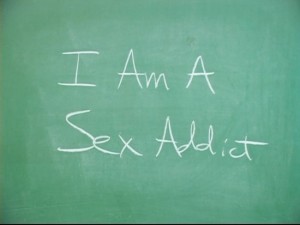 In our fourth post in Shame Week, Dr Katherine Angel of Warwick University’s Centre for the History of Medicine considers Steve McQueen’s new film, Shame. She argues that McQueen’s recent interviews characterising the work as ‘a film about sex addiction’ crudely medicalises and pathologises what is in fact a subtle and nuanced cinematic exploration of desire and suffering.
In our fourth post in Shame Week, Dr Katherine Angel of Warwick University’s Centre for the History of Medicine considers Steve McQueen’s new film, Shame. She argues that McQueen’s recent interviews characterising the work as ‘a film about sex addiction’ crudely medicalises and pathologises what is in fact a subtle and nuanced cinematic exploration of desire and suffering.
The opening shot of Shame is of its protagonist, Brandon, lying on a bed. We see him from above, from about ceiling-height. He is still, pale, and glassy-eyed. The scene is a little longer than is comfortable, and invites us to wonder if this body we are looking at is a corpse. But no – the man moves, and climbs out of bed. As the next couple of days unfold, we are given a picture of a New York office worker in his mid-thirties, whose routine is peppered with pornography, masturbation, the chasing of casual encounters, and visits from prostitutes.
Michael Fassbender, and the cinematography, are remarkable. Together they reveal two Brandons, embodied in startlingly different ways. One is a deadened, absent figure – McQueen sometimes blurs his face; he is still, heavy, and grey. In these scenes he recedes, and almost vanishes. The other is a compelling and poised figure, drawing the desire of others towards him. Fassbender accomplishes this not so much through words, but rather by conveying the sense of an altogether different energy coursing through him – an energy searching for something to want and have, a need to be wanted, and an openness otherwise unavailable to him.
Brandon’s younger sister Cissy comes to stay, and her presence – needy, voluble, dramatic – provokes a simmering rage in him that is unnerving to her and the audience. The tensions between the two are triangulated by the flirtation between Cissy and Brandon’s boss. An opening of light into Brandon’s muffled life is provided by a date with a colleague, but he is unable to become physically aroused when in bed with her. After a row with Cissy, Brandon spends a night in bars and clubs, pursuing a series of sexual encounters.
 This sequence is one of the most powerful in the film. It includes an uncomfortable scene when he talks in an increasingly explicit way with a woman at a bar – flirting isn’t quite the right word – eventually reaching his hand under her skirt. He then provokes her boyfriend by relaying the details of their conversation. It’s a scene with complex layers: He is exciting the woman, but also knowingly disturbing her. He isn’t exactly pursuing her, but rather displaying himself to himself. He is humiliating the boyfriend, but perhaps attempting to humiliate himself too. He is observing himself with bitter recognition, testing his own capacity for provocation, and inviting the anger and disgust of others. The scene ends with an exquisitely ambivalent grimace of triumph and self-knowledge on his face. We then see him with two prostitutes. Against the lush and dark soundtrack by Harry Escott, Brandon’s absorption in the physical abandon is intensely moving – we sense the release, both physical and emotional, that he finds there – but Fassbender and McQueen resist any easy resolution: the scene culminates with him looking out at us, his face a dizzying mix of abandon and distress.
This sequence is one of the most powerful in the film. It includes an uncomfortable scene when he talks in an increasingly explicit way with a woman at a bar – flirting isn’t quite the right word – eventually reaching his hand under her skirt. He then provokes her boyfriend by relaying the details of their conversation. It’s a scene with complex layers: He is exciting the woman, but also knowingly disturbing her. He isn’t exactly pursuing her, but rather displaying himself to himself. He is humiliating the boyfriend, but perhaps attempting to humiliate himself too. He is observing himself with bitter recognition, testing his own capacity for provocation, and inviting the anger and disgust of others. The scene ends with an exquisitely ambivalent grimace of triumph and self-knowledge on his face. We then see him with two prostitutes. Against the lush and dark soundtrack by Harry Escott, Brandon’s absorption in the physical abandon is intensely moving – we sense the release, both physical and emotional, that he finds there – but Fassbender and McQueen resist any easy resolution: the scene culminates with him looking out at us, his face a dizzying mix of abandon and distress.
Shame has a light touch. It does not give us a heavy-handed backstory, and is both empathetic and unwavering. It lets complex characters and situations emerge, allowing ambiguity throughout, and especially so at the end. It is, in other words, subtle and complex – something that contrasts somewhat with the Steve McQueen’s gloss on his own film in interviews.
 The film, he says, is about sex addiction – analogous to alcohol or drug addiction, but less recognised than these. The film was made in New York, he says, partly because of difficulties finding interviewees to discuss sex addiction in the UK; in the US, doctors and patients abounded. A model of sex addiction analogous to alcohol addiction, with similar 12-step programmes, has been around longer in the States than in the UK, and is a lay model that circulates increasingly widely. But sex addiction is not an uncontested category. It is not listed as such in the current DSM, the manual of the American Psychiatric Association, although individuals can be and are categorized under Sexual Disorder Not Otherwise Specified. In the controversial process to revise DSM for its fifth edition due in 2013, Hypersexual Disorder is being discussed for inclusion. The criteria include excessive time consumed by sexual urges, and planning and engaging in sexual behaviour; repetitive engaging in sexual behaviour as a response to dysphoric mood states, or to stressful life events; repetitive engaging in behaviour while disregarding risks to self and others – all with the proviso that the behaviour must cause significant personal distress or impairment in functioning. (The International Classification of Disease is less loquacious than the DSM on this and other matters; but it includes Excessive Sexual Drive as a category, specified as satyriasis in men and nymphomania in women – preserving an older sexological language that the DSM’s nomenclature has sought to replace.)
The film, he says, is about sex addiction – analogous to alcohol or drug addiction, but less recognised than these. The film was made in New York, he says, partly because of difficulties finding interviewees to discuss sex addiction in the UK; in the US, doctors and patients abounded. A model of sex addiction analogous to alcohol addiction, with similar 12-step programmes, has been around longer in the States than in the UK, and is a lay model that circulates increasingly widely. But sex addiction is not an uncontested category. It is not listed as such in the current DSM, the manual of the American Psychiatric Association, although individuals can be and are categorized under Sexual Disorder Not Otherwise Specified. In the controversial process to revise DSM for its fifth edition due in 2013, Hypersexual Disorder is being discussed for inclusion. The criteria include excessive time consumed by sexual urges, and planning and engaging in sexual behaviour; repetitive engaging in sexual behaviour as a response to dysphoric mood states, or to stressful life events; repetitive engaging in behaviour while disregarding risks to self and others – all with the proviso that the behaviour must cause significant personal distress or impairment in functioning. (The International Classification of Disease is less loquacious than the DSM on this and other matters; but it includes Excessive Sexual Drive as a category, specified as satyriasis in men and nymphomania in women – preserving an older sexological language that the DSM’s nomenclature has sought to replace.)
Proponents of the disorder suggest that there is a significant clinical need for it, with many individuals seeking treatment – regardless of diagnosis – in psychotherapy and 12-step programmes. Moreover, they emphasise, those manifesting compulsive and high-volume sexual behaviour are at higher risk of acquiring and disseminating sexually transmitted diseases, as well as suffering the destructive impact on relationships and marriages. The public health implications of sexual appetite, of impulse control, and of internet pornography are key figures in concern about compulsive or addictive sexual behaviours.
This terminology of sexual addiction, hypersexuality, or sexual compulsivity is controversial, with debates abounding over a pathologisation of sexuality and the norms of sexual behaviour embedded within them. This is, as ever, a question of language – and McQueen’s insistence on sex addiction as the theme of the film is a strangely blunt tool to describe his work. Shame is a remarkable portrait of suffering – suffering that primarily manifests in, and is temporarily resolved through, though never entirely dislodged by, intense sexual activity. It ‘s about how suffering can be expressed; about the limited outlets for experience and suffering that Brandon allows himself. It’s about exquisite pain, and it’s testament to both McQueen and Fassbender that when we watch this portrait, we feel it too.
McQueen has also said that people struggle to understand the idea of a film about sex that is not sexy; that does not aim to excite or titillate. Here again, his own glossing of his work is a surprising contrast to it. To insist that Shame is not at some level erotic is to underplay how it brings to life both the intense pull and satisfaction of sex, and its shadow – its capacity to stand in for other kinds of pleasures, longings and disappointments, to obscure and muffle other feelings. The film both shows us how compelling the fulfilment of sexual desire can be, and shows us how desire, more widely understood, can get distributed within a person. Brandon doesn’t really want anything; at a restaurant, he is indifferent to his choices. His life feels anonymous, his apartment bland, inexpressive of anything he might want or love. And yet it is only within sexual desire that his desire in general can come alive.
McQueen’s work as an artist is complex and resonant, but his statements about his film are disappointing. This makes me think that he is either not fully cognizant of the beauty and complexity of his creation, or adopting a particular language – a medical language – through which compassion can be channeled, and through which discomforts about portrayals of both suffering and sexuality can be managed, in order to negotiate the press circus and to render the film more palatable.
A similar point can be made about the handling of ideas of gender in the film – of which McQueen has been silent. It is interesting that Brandon’s rage is so intensely provoked by witnessing his sister’s desire for sex, but also desire for connection, love, and support. In a restaurant on a date, the woman he is with does know her desire, and is unafraid to open up the questions about love and relationships that Brandon is so closed to; and yet when she starts to express a wine preference, the male waiter cuts her off, and she defers. Women’s desire is the silent partner – tantalisingly glimpsed – to Brandon’s suffering in the film.
McQueen also deftly raises questions of gender in the interactions between Brandon and his boss David, in which we see the calibration of masculinity at work in relation to conquests of women. In a bar, David pursues a woman who is instead drawn to Brandon’s quiet and elusive charm. The next day, not knowing – but suspecting – that Brandon and the woman in question did seduce one another, David suggests another outing. They agree on a location, and Dave says ‘And I’ll ruin your night’ – a powerful flicker of threat surging into a mundane office moment. It is that night that he meets Cissy, with whom he has sex in Brandon’s apartment. Here we see the aggressive negotiations of gender identity and power that can give desire and conquest its energy.
What is avoided in the film, but obtrusive in its reviews, however, is the question of the gendered nature of ideas about appropriate sexual behaviour. One review tells us that there is ‘a long tracking scene in which Brandon, driven from his apartment by his sister’s slutty behaviour, jogs furiously for several blocks through Manhattan, trying to run his anger out of his system.’ Another claims that Cissy ‘throws herself at any passing male as a kind of mirror pathology’. This is fascinating: Brandon is a sex addict, but his sister’s behaviour is ‘slutty.’ And these assessments are curious because all we see is Cissy spend one night with David, against the background of Brandon’s far more intense level of sexual activity. The availability, that is, of a far more judgemental language about sexual behaviour in women creeps into the critical response to the film.
How we read casual sex, then, is evidently gendered. A film about ‘sex addiction’ in women would no doubt look and feel very different. And so how we read Shame, the film, and shame, the feeling, should perhaps also be filtered through gender, because the coverage of Shame can be read as an instance of the need to wield shame against others. Shame is a beautiful and subtle film, and ways of talking about it reveal the narrative difficulties of describing sex, suffering, and desire. So go and see it – just don’t trust anything you read about it.
Dr Angel’s book, Unmastered: A Book On Desire, Most Difficult to Tell, is published later this year by Allen Lane.

Your paragraph next to the second photo(ending in ‘distress’) is beautifully written.
Pingback: Shameless | The History of Emotions Blog
Thank you Jonathan!
Language is complex.
Some people, including some sex workers themselves, object to use of the word ‘prostitute’. It can be construed as dehumanising, especially when you say no more about these women (I assume they are women though you do not specify) than the fact they are ‘prostitutes’.
Hi Quiet Riot Girl. I agree, language is very complex. I used the word ‘prostitute’ here because I find the term ‘sex worker’ sounds, in this context, too vague and general. I think much depends on how one uses a word, rather than just the particular words one chooses. You’re right I don’t go into much detail about the (female) prostitutes/sex workers in the film – I chose to focus on the Brandon character in particular. I think there is something interesting, though, about the way Fassbender chose to represent the women in this scene. It’s quite deftly and lightly portrayed, and in fact not massively clear whether they are prostitutes/sex workers or not (in this scene I describe, rather than one of the earlier scenes in the film I don’t go into) – it was only on second viewing it became clearer. And his portrayal of women as a whole, be they partners/casual encounters/prostitutes/sex workers, is fascinating – by far the most subtle and empathetic I’ve seen in a film this big for a long time. Would need a whole other blog really!
Check out this hypercaffeinated piece – makes some similar points.
http://thelastpsychiatrist.com/2012/03/shame.html